
Antaresia is a genus of pythons, nonvenomous snakes in the family Pythonidae. The genus is native to Australasia. The genus is known by the common name Children's pythons, the name of the type species, Antaresia childreni. Gray named A. childreni in honour of his mentor, John George Children, who was a curator of the zoological collection at the British Museum around that time. It contains the smallest members of the Pythonidae. Four species and two subspecies are recognized, although they were all considered part of the same species until recently. A newly described form called the pygmy banded python may be a distinct species, but analysis has not yet been performed on this animal. The largest recorded examples of Antaresia species have all been males, suggesting males of the known species in this genus may compete for females. This behavior has never been witnessed in the wild, and has only been witnessed in captive specimens.

The Green tree Python, is a species of snake in the family Pythonidae. The species is native to New Guinea, some islands in Indonesia, and the Cape York Peninsula in Australia. First described by Hermann Schlegel in 1872, it was known for many years as Chondropython viridis. As its common name suggests, it is a bright green snake that can reach a total length of 2 m (6.6 ft) and a weight of 1.6 kg (3.5 lb), with females slightly larger and heavier than males. Living generally in trees, the green tree python mainly hunts and eats small reptiles and mammals. It is a popular pet, and numbers in the wild have suffered with large-scale smuggling of wild-caught green tree pythons in Indonesia. Despite this, the green tree python is rated as least concern on the IUCN Red List of endangered species.

Children's python is a species of nonvenomous snake in the family Pythonidae. The species is named after John George Children. It is a nocturnal species occurring in the northern half of Australia and generally found on the ground, although it often climbs trees. Usually growing to about 1.0 m (3 ft) in length or more depending on the polymorphic variant, it is typically a reddish-brown colour, darker on the upper surface, and with many darker blotches, especially on younger specimens. The Stimson's python variant has much stronger and more variable colours; often being adorned with reddish-brown to chocolate blotches against lighter tan. It feeds mostly on small mammals and birds, and as with other pythons, it constricts its prey before swallowing it whole. It is a popular pet among reptile enthusiasts.

The spotted python, eastern small-blotched python, or eastern Children's python is a python species found in northern Australia and New Guinea. It is a popular pet among Australian reptile enthusiasts and other reptile enthusiasts abroad due to its small size and even temperament. No subspecies were originally recognized. However, two subspecies were recognized as of 2020; A. m. maculosa and A. m. peninsularis.
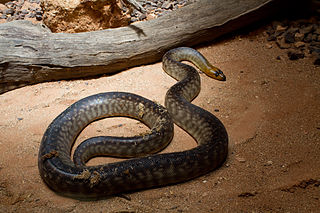
The woma python, also known commonly as Ramsay's python, the sand python, and simply the woma, is a species of snake in the family Pythonidae, endemic to Australia. Once common throughout Western Australia, it has become critically endangered in some regions.

The Central African rock python is a species of large constrictor snake in the family Pythonidae. The species is native to sub-Saharan Africa. It is one of 10 living species in the genus Python.

The amethystine python, also known as the scrub python or sanca permata in Indonesian, is a species of non-venomous snake in the family Pythonidae. The species is found in Indonesia and Papua New Guinea. Popular among reptile enthusiasts, and noted for its coloration and size, it is one of the largest snakes in the world, as measured either by length or weight, and is the largest native snake in Papua New Guinea. Until 2000, the larger S. kinghorni was generally considered a subspecies of S. amethistina, and this change of classification has still not been universally reflected in literature. Because of this issue, S. amethistina has often been described as the largest snake in Australia, but this is not accurate since under the current classification, this species does not occur in Australia.

The eastern pygmy possum is a diprotodont marsupial of south-eastern Australia. Occurring from southern Queensland to eastern South Australia and also Tasmania, it is found in a range of habitats, including rainforest, sclerophyll forest, woodland and heath.

The rough-scaled python is a large-scaled python species endemic to Australia. No subspecies are currently recognized.

The Oenpelli python or Oenpelli rock python is a species of large snake in the family Pythonidae. The species is endemic to the sandstone massif area of the western Arnhem Land region in the Northern Territory of Australia. There are no subspecies that are recognised as being valid. It has been called the rarest python in the world. Two notable characteristics of the species are the unusually large size of its eggs and its ability to change colour. It is the longest snake native to the Northern Territory.
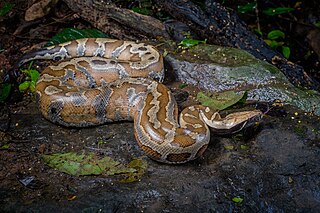
Python brongersmai is a species of nonvenomous snake in the family Pythonidae. The species is native to Southeast Asia.

Morelia spilota spilota is a subspecies of carpet python, popularly known as the diamond python. It is a medium to large snake, found in coastal areas and adjacent ranges of south-eastern Australia. It is the most southerly occurring python in the world and is found at higher altitudes than any other species of Australian python.

Python anchietae is a python species endemic to southern Africa. According to Donald George Broadley (1990), this species is most closely related to the ball python of western Africa, and no subspecies are currently recognized. It is named after the Portuguese naturalist and explorer José Alberto de Oliveira Anchieta. Like all other pythons, it is not venomous.
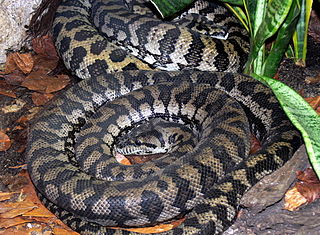
Morelia spilota variegata, commonly known as Torresian carpet python, Darwin carpet python or northwestern carpet python, is a subspecies of python found in New Guinea and Australia, smaller than the nominate subspecies Morelia spilota spilota and has a more restricted geographic range.
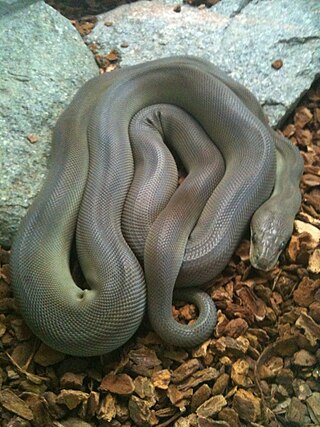
The olive python is a species of snake in the family Pythonidae. The species is endemic to Australia. Two subspecies are recognized, including the nominate subspecies described here.
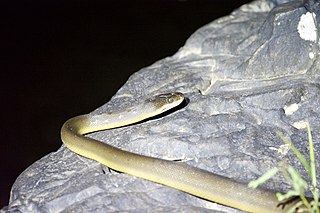
The water python is a python species found in Australia and Papua New Guinea. No subspecies are currently recognized. Like all other pythons, it is not venomous.
Liasis olivaceus barroni is a python found in the Pilbara region of northwest Australia. They are recognised as a subspecies of Liasis olivaceus, separating the population from the olive python found to the east. It is a large snake, most often around 2.5 metres in length, although individuals may attain a larger size. The python is an ambush predator, using a sit and wait method at a path or beneath the water to capture a variety of animals that inhabit the arid surroundings. The range of prey includes amphibians, birds and other reptiles, and mammals as large as a rock wallaby.
The spotted mulga snake, also known commonly as Butler's black snake and Butler's snake, is a species of venomous snake in the family Elapidae. The species is endemic to Western Australia. It is a member of the genus Pseudechis, dangerously venomous snakes that can intimidate an opponent by raising the head and presenting a hood. This cobra-like threat display is supported by the ability to produce a very large amount of venom.
















